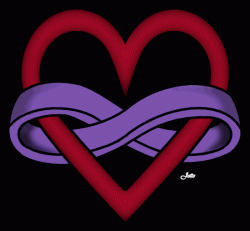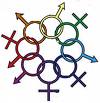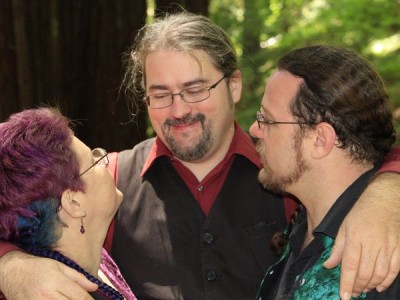EDIT (17 January 2013): Please see update below.
The scene is San Francisco, late 2009, and a friend is explaining—animatedly, excitedly—“why there are so many poly [polyamorous] people on OkCupid.” I wasn’t paying much attention to online dating at the time, so the precise details are fuzzy, but it basically boiled down to the options that OkCupid offered for “relationship status.” In addition to the expected categories like “single,” “seeing someone,” or “married” offered by other social networking and dating sites, OkCupid offered the label “available.”
To know why this distinction would matter to someone who identifies as “poly” or “polyamorous” (as did this particular friend), you need to know a little bit about what polyamory is. In an oversimplified nutshell: if monogamy is being in one romantic relationship while having one sexual partner (who are the same person), and non-monogamy is having more than one sexual partner (while having one or zero romantic relationships), then polyamory is openly having more than one romantic relationship (usually while having more than one sexual partner). While a non-monogamous couple in a “swingers” scene might have casual sex with other partners but limit their romantic/dating activities to each other, a poly couple often has romantic relationships with other partners rather than just casual sex. (Nor are all poly partnerships couples; committed poly triads are not all that uncommon.)

“Available” was therefore an important distinction to my friend, who was in a polyamorous marriage. His wife had several boyfriends (whom he knew, and whom she dated with his blessing); he was interested in dating as well and, as an introvert, found online dating to be a more comfortable way of meeting prospective partners. When he identified as “married” or “in a relationship,” however, women who viewed his profiles often read “off the market” (or in one case, approached him for an illicit affair); the algorithms behind the sites also didn’t show his profile to people who were seeking “single” matches. Identifying as “single” would have gotten the algorithms to behave, but he didn’t want to mislead prospective partners or to insult his wife by denying their marriage.
“Available” offered a much more appealing option, both as a relationship status and as a search category. As a status, it was an easy way for him to signal, “hey, you can date me, but I am something other than single.” And because “available to date” and “not in a relationship” were no longer treated as synonymous in the catch-all category “single,” the algorithms behind OkCupid would show his profile to people who wanted to date, but didn’t mind if their new partner had a partner. (It’s important to note, however, that my friend’s enthusiasm for “available” is not shared by all poly OkCupid users; others find the term too general to be useful.)
 I don’t know my OkCupid history that well, so I’m not sure if OkCupid’s reputation and status as a poly-friendly dating site came from the fact that it offered the “available” status, or if it started offering the “available” status based on popular demand from its users. What I do know is that last week, as I was going through the process of signing up for OkCupid as a fictitious 18-year-old boy (as research for another piece of writing), I was surprised to find the “available” category missing. When you first sign up for OkCupid, it now offers only three relationship statuses: “I’m single,” “I’m seeing someone / here for friends,” and “I’m married / here for friends.” Once you’ve completed the registration process, these categories collapse even further: as a registered user, you can choose from “single,” “seeing someone,” and “married” only.
I don’t know my OkCupid history that well, so I’m not sure if OkCupid’s reputation and status as a poly-friendly dating site came from the fact that it offered the “available” status, or if it started offering the “available” status based on popular demand from its users. What I do know is that last week, as I was going through the process of signing up for OkCupid as a fictitious 18-year-old boy (as research for another piece of writing), I was surprised to find the “available” category missing. When you first sign up for OkCupid, it now offers only three relationship statuses: “I’m single,” “I’m seeing someone / here for friends,” and “I’m married / here for friends.” Once you’ve completed the registration process, these categories collapse even further: as a registered user, you can choose from “single,” “seeing someone,” and “married” only.
Jenny Davis (@Jup83) wrote last fall about identity prosumption on the social networking sites Facebook and Fetlife, and in her piece examines how the two sites differ with respect to both “collective vs. individualist orientation” and “control over identity meanings.” The structure of a Facebook profile puts more emphasis on a person’s individual identities, while the structure of a FetLife profile puts more emphasis on a person’s group member identities. Similarly, Facebook offers more open-ended response fields on its profile form, which allows for more flexibility in self-definition, whereas FetLife offers more drop-down menus with pre-set identity categories (and therefore structures identity prosumption by providing the categories into which people self-select). While I don’t know how significant OkCupid is or was as a site of poly identity prosumption, Davis’s work is instructive here because it shows the impact of online profile structures’ differing affordances.

While I can’t speak to the significance of OkCupid as a site of poly identity prosumption, that OkCupid is a site of poly identity prosumption is not in question. Poly OkCupid users developed ways of doing/being[i] poly on the site, which usually involved using the relationship status “available,” using the term “poly” or “polyamorous” (or both) in one’s profile keywords, and linking to one’s partner’s profile (if one’s partner was also on OkCupid). In so doing, people experienced with polyamory and online dating not only taught others how to write poly-friendly dating site profiles, but also demonstrated to the newly poly what “being poly” means: for instance, that one should be clear and forthcoming about one’s existing relationships, that one should expect to know about one’s partner’s other relationships, and that one should expect to get to know one’s new partner’s other partner(s).
This makes the prosumption of poly identity on OkCupid an interesting contrast to Davis’s examination of identity prosumption on Facebook and FetLife. Both “polyamorous” and “BDSM enthusiast” are largely considered “deviant” identities (despite what life in San Francisco might lead one to believe), and therefore have fewer well-known scripts and templates for their performance. Yet where “FetLife, through its templated categories, prominently posted norms, and dropdown menus, guides prosuming subjects through the process of BDSM identity prosumption,” poly identity prosumption was (at the time) structured both by OkCupid’s templates (choosing the “available” status) and by poly OkCupid users’ creative appropriation of the site’s more open-ended features (searchable and clickable keywords, linking to other profiles) to create poly-specific practices (using the term “poly” as a keyword, linking to one’s partner’s profile).

I really wish I’d been paying attention to this over the last few years, because now I have a bunch of questions I don’t have the data to answer. First, does anyone know when the “available” category disappeared? (And did its disappearance have anything to do with the more traditional/mainstream dating site Match.com purchasing OkCupid in 2011?) Second, how has the disappearance of the “available” category changed users’ experiences on OkCupid generally, and poly identity prosumption on OkCupid specifically? Third, what new practices (if any) have poly OkCupid users developed to route around the fact that “single” is once again the catch-all term for “on the market,” while new users are rather explicitly told by OkCupid that people who are “seeing someone” or “married” should only be looking for friends? I’m interested in hearing more about this, particularly from poly OkCupid users.
UPDATE (17 January 2013, evening): It turns out I should have titled this post “‘Available’ is Not Readily Available.” The emerging consensus from my Twitter feed in response to this post is that the “available” status still exists, but is not—and may never have been—a status that one can select directly. Instead, the “available” status has to be “unlocked” (my term) by selecting an appropriate combination of options in the “status” and “looking for” categories. The [up-up-down-down-left-right-left-right-B-A-start] for “available” on OkCupid is selecting either “seeing someone” or “married” for one’s status, and checking any/all of “short-term dating,” “long-term dating,” or “casual sex” in the “I’m looking for” category. After doing so, a user will appear as “available” throughout the site.
Most of the rest of this post still stands, however, and I’d love to hear from readers about how—or if—you think the indirect selection of the “available” status affects poly identity prosumption on OkCupid.
Whitney Erin Boesel is on Twitter: she’s @phenatypical.
Triad in bathtub photo from http://gaypoly.wordpress.com/
Polyamory symbol from http://2.loverules.info/3501
Poly gender keychain image from http://cindykesey.wordpress.com/2008/03/08/the-ultimate-meetup-polyamory-in-second-life/
Four-person poly relationship photo from http://www.ontheragmag.com/watch/polyamory-married-and-dating/
Poly triad photo from http://romantiqueinnocence.blogspot.com/2012/01/lovely-couple-no-just-odd-couple-arent.html
[i] Whether “poly” is an identity, an orientation, a practice, a status, or some combination of the above (or none of the above) is up for debate, and I find that debate particularly fascinating.


Comments 5
Angela — January 17, 2013
I could be wrong, but I don't remember there originally being an "available" option. However, one can still show up as "available" by including the various "dating' options in the "I'm looking for" section. It may have always been this way (but again, my memory isn't solid on this fact).
jennydavis — January 17, 2013
Great piece!! I think this is a wonderful counter to my fetlife post. Here, users navigate the space in highly agentic ways to prosume poly identity, whereas on fetlife the space does much of this work for the user. However, both are rich in terms of identity prosumption, in that root of the identity is embodied desire. Illustrating identity prosumption through embodied desire highlights the intertwined relationship between nature, culture, the body, and material conditions of interaction.
Wendy — January 17, 2013
When I signed up for OKC nearly a decade ago, there wasn't an "available" option. To my knowledge there never has been. However, if you choose a relationship option other than single and "dating" or "casual sex" under the "I'm looking for" section, your profile will show you as "available".
I'm poly, and my OKC profile is linked to both my husband and boyfriend. I show as "married" because I chose only looking for friends or activity partners, not dating or sex.
Friday Roundup: January 18, 2013 » The Editors' Desk — January 18, 2013
[...] James Vincent on the “New Aesthetic,” Whitney Erin Boesel on dating sites limiting daters’ self-identification options, Jenny Davis and Sarah Wanenchak on the “real” thing, Doug Hill greets his robot [...]
OldOKCuser — May 29, 2013
Now even the "unlock option" doesn't work. If you managed to get available and go to look at their options now you will on be able to select Single, Seeing Someone/Friends Only, Married/Friends Only. I'm surprised at how hurt this left me feeling.